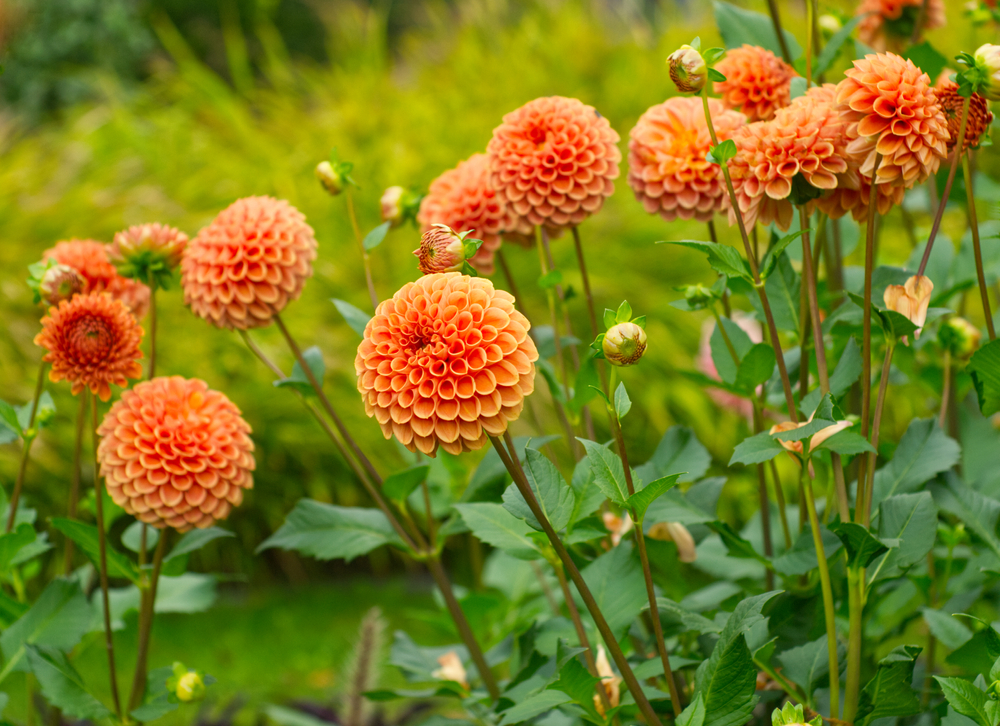Dahlias, the dazzling stars of the garden, is a genus of flowering plants that belong to the Asteraceae family. Revered for their stunning and diverse blooms, dahlias have captured the hearts of gardeners and floral enthusiasts around the world. This botanical marvel boasts a rich history, an extensive variety of cultivars, and a multitude of uses. This makes it a perennial favorite in gardens, bouquets, and horticultural exhibitions.
Interested in Flowers, learn about Tulips.
About Dahlias Flowers
Dahlias are low-maintenance plants that bloom beautifully from mid-summer until October. “Tomato culture” and “dahlia culture” are comparable in many ways. They are easy to plant if you know how to grow tomatoes in your garden. The following pointers will assist you in enhancing your garden with breathtaking blossoms and vibrant colors!
Selecting a preferred dahlia is akin to searching through a button box! The flowers can be as small as 2-inch pompoms in the shape of lollipops or as large as 15-inch “dinner plates.” The majority reach heights of 4 to 5 feet. White, yellow, orange, pink, dark pink, red, dark red, lavender, purple, and black, as well as light blend, bronze, flame, dark blend, variegated, and bicolor, are just a few of the stunning hues that these flowers grow in!
The genus Dahlia comprises tuberous plants that belong to the Asteraceae family. The tubers are usually planted in the ground in late spring, around May, and bloom from July until the first frosts of October. These flowers create beautiful cut flowers and are ideal for a border garden. Vegetable gardening? You should position them in a row along the edge so they won’t shade your edibles.
Here is a general overview of Dahlia flowers by The Spruce:
| Common Name | Dahlia |
| Botanical Name | Dahlia spp. |
| Family | Asteraceae |
| Plant Type | Perennial |
| Flower Color | Red, Pink, Orange, Yellow, Purple, White |
| Soil Type | Loamy, Well-Drained |
| Sun Exposure | Full |
| Mature Size | 1-6 ft. tall, 1-3 ft. wide |
Origin and History
Dahlias have a storied history originating in the mountainous regions of Mexico and Central America. Indigenous communities, including the Aztecs, were among the first to cultivate and appreciate these vibrant flowers.
Historical records suggest that they served not only as ornamental plants but also as a practical resource. Its tubers were consumed as a food source and also believed to possess medicinal properties.
The journey of these flowers from their native habitat to Europe began in the 18th century when Spanish botanist Abbe Antonio Jose Cavanilles played a pivotal role in introducing them to the European botanical community. To honor the Swedish botanist Anders Dahl, the plant was named “Dahlia.”
Despite their early popularity in Mexico and Central America, they gained widespread recognition and appreciation in Europe, becoming a beloved garden and ornamental plant.
This rich history intertwines the cultural significance of dahlias with their journey from indigenous uses to global horticultural prominence. The name “Dahlia” stands as a testament to the botanical contributions of Anders Dahl and the enduring appeal of these captivating flowers.
Botanical Characteristics
Dahlias, belonging to the Asteraceae family, are celebrated for their striking diversity in size, shape, and color. These herbaceous perennials grow from tubers and boast lush, dark green foliage that provides an elegant backdrop to their vibrant blooms. The true allure of dahlias lies in their flowers, which range from small and delicate to large and showy.
The variety in flower forms is a hallmark of dahlias, with classifications including decorative, cactus, anemone, waterlily, and ball dahlias. Decorative dahlias feature large, fully double blooms with broad, flat-topped petals, while cactus dahlias showcase spiky, tubular petals resembling cactus flowers. Anemone dahlias have a central disc surrounded by flat petals, waterlily dahlias exhibit open, flat blooms, and ball dahlias present rounded, ball-shaped blooms.
The color palette of these flowers is as diverse as their forms, spanning the spectrum with shades of red, orange, yellow, pink, purple, and white. This botanical diversity allows for endless possibilities in garden design and floral arrangements, making dahlias a favorite among gardeners and florists alike.
Cultivation and Care
Cultivating these flowers is a rewarding endeavor, as these plants are relatively easy to grow, making them suitable for both novice and experienced gardeners. The first step in growing dahlias is obtaining tubers from reputable sources. You should plant them in the spring, ensuring the frost risk has passed.
Dahlias thrive in well-draining soil and require full sun for optimal growth. You should plant the tubers at a depth appropriate for the specific cultivar. The spacing is determined by the size of the variety, with larger dahlias generally requiring more space. Regular watering is crucial, especially during dry periods, to promote robust growth and abundant blooms.
As they develop, providing support, such as stakes, can prevent the stems from bending or breaking under the weight of the blooms. Deadheading, or removing spent flowers, encourages the plant to produce more blooms, extending the flowering period. In regions with harsh winters, dahlias may not survive outdoors, and the tubers should be dug up and stored in a cool, dry place until the following spring.
The cultivation and care of dahlias go beyond the basics, encompassing the joy of nurturing these plants and witnessing their spectacular display of colors and forms throughout the growing season. Gardening enthusiasts find satisfaction in the process of tending to dahlias, ensuring their well-being and maximizing their ornamental potential.
Dahlias in Gardens and Bouquets
Dahlias seamlessly transition from garden stars to captivating elements in floral arrangements and bouquets. Their versatility in size, form, and color allows for creative and stunning combinations that cater to various tastes and occasions.
Garden Elegance
In gardens, these flowers often serve as focal points, creating a kaleidoscope of color and form. Whether planted in beds or borders, their bold blooms draw attention and contribute to the overall beauty of the landscape. The variety in size and form allows for strategic placement, ensuring a harmonious and visually appealing garden design.
Floral Artistry
They are prized additions to floral arrangements and bouquets. From sophisticated wedding bouquets to vibrant centerpieces, the diverse shapes and colors of dahlias provide endless possibilities for creative expression. Their ability to complement other flowers makes them sought-after by florists looking to add depth and interest to their designs.
Season-Long Beauty
One of the remarkable features of these flowers is their extended blooming season, often lasting from summer well into the fall. This longevity ensures a continuous supply of fresh blooms for garden display and floral arrangements. Dahlias have become the go-to choice for those looking to infuse their gardens and bouquets with a burst of color when many other flowers have faded.
Complementary Combinations
Dahlias harmonize effortlessly with a variety of companion plants. Whether paired with perennials, annuals, or other bulbous flowers, dahlias contribute to dynamic and visually engaging combinations. Their ability to enhance the overall aesthetic appeal of mixed plantings makes them valuable assets in the hands of gardeners and landscape designers.
Interested in Flower, learn about sunflowers.
Horticultural Exhibitions
They take center stage at horticultural exhibitions and flower shows, where enthusiasts showcase the incredible diversity within the Dahlia genus. These events provide a platform for growers to display their prized specimens, compete for awards, and contribute to the ongoing cultivation and development of new and exciting varieties.
Showcasing Diversity
Horticultural exhibitions celebrate the vast array of dahlia varieties, each vying for attention with its unique characteristics. From the intricate petals of cactus dahlias to the classic beauty of decorative dahlias, these events showcase the diversity that has been cultivated and refined by passionate growers.
Judging Criteria
Judges at horticultural exhibitions evaluate dahlias based on various criteria, including bloom size, form, color, and overall plant health. This meticulous judging process ensures that the most exceptional specimens are recognized and awarded. The competitions not only celebrate the beauty of dahlias but also motivate growers to continually refine and improve their cultivation practices.
Community and Camaraderie
Participating in horticultural exhibitions has become a beloved tradition for many dahlia enthusiasts. These events foster a sense of community and camaraderie among growers who share a passion for these botanical wonders. The exchange of knowledge, tips, and stories creates a supportive network that further enhances the Dahlia-growing experience.
Cultivating Excellence
Beyond the competitive aspect, horticultural exhibitions contribute to the cultivation of excellence within the dahlia community. Growers often strive to introduce new varieties that push the boundaries of color, form, and size. The pursuit of excellence showcased at these exhibitions drives innovation and ensures that dahlias remain at the forefront of horticultural fascination.
Dahlias FAQs
What is special about dahlias?
The profusion of flowers that dahlia produces is one of the best things about planting them. Midsummer is when dahlias begin to bloom, and they don’t stop until September. Simply sow the tubers in the spring, then get ready to be astounded!
What are the ideal growing conditions for dahlias?
Dahlias thrive in well-draining soil and require full sun for optimal growth. Plant tubers in the spring after the last frost. Water them regularly, and provide support for the stems, especially for larger varieties. In regions with harsh winters, dahlias should be dug up and stored until the following spring.
How diverse are dahlias in terms of size, shape, and color?
Dahlias are incredibly diverse. They come in various sizes, ranging from small to large, and exhibit different flower forms, including decorative, cactus, anemone, waterlily, and ball dahlias. The colors of dahlias span the entire spectrum, offering shades of red, orange, yellow, pink, purple, and white.
Can you use dahlias in floral arrangements and bouquets?
Yes, dahlias are a popular choice for floral arrangements and bouquets. Their diverse shapes and colors make them versatile for both formal and informal displays. Whether in elegant wedding bouquets or vibrant centerpieces, dahlias add a touch of beauty and sophistication.
What is the significance of horticultural exhibitions for dahlias plant?
Horticultural exhibitions provide a platform for dahlia enthusiasts to showcase their prized specimens. Judges evaluate factors such as bloom size, form, color, and overall plant health to determine winners. These events foster a sense of community among growers and contribute to the cultivation and development of new and exciting dahlia varieties.
Conclusion
Dahlias, with their rich history, botanical diversity, and stunning blooms, stands as a testament to the beauty and resilience of nature. From their humble origins in the mountains of Mexico to their current status as beloved garden and floral favorites, dahlias continue to captivate and inspire.
Whether gracing gardens with their vibrant hues, adorning bouquets with their intricate forms, or competing for accolades at horticultural exhibitions, dahlias have earned their place as one of the most cherished and versatile plants in the world of horticulture.
Embracing the magic of dahlia is not just an appreciation of their aesthetic qualities but a celebration of the intricate dance between nature and human cultivation that has brought these botanical wonders into our lives.

